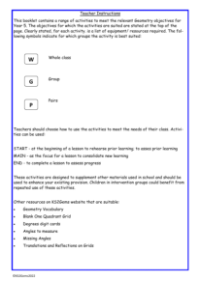Missing lengths and angles worksheet

Maths Resource Description
In a series of engaging activities designed for key stage 2 pupils, the aim is to explore the properties of shapes and to deduce missing lengths and angles. Activity 1 starts with each child receiving a square piece of paper. The task is to measure the angles of the square, which should all be 90 degrees. Then, the square is folded diagonally to form a triangle, prompting the children to consider the angles of the new shape. This hands-on approach helps students understand the geometric relationship between a square and the triangles formed within it.
Activity 2 shifts the focus to rectangles. Children are provided with rectangular pieces of paper and first measure the angles, which, like the square, should also be 90 degrees. The rectangle is then folded diagonally, creating triangles within the rectangle. The children are asked to observe and measure the angles of these triangles, facilitating an understanding of how a rectangle's properties influence the angles of the triangles formed from it. In Activity 3, using rectangles of paper and scissors, children are challenged to create a square and a rectangle from a single sheet, exploring the various ways this can be accomplished. The objective of these activities is to use the properties of rectangles to deduce related facts and find missing lengths and angles, enhancing their reasoning and problem-solving skills.
Finally, Activity 4 involves the use of equilateral triangle templates. Each child is tasked with arranging their triangle template four times to create a new shape, ensuring that the sides or vertices touch but do not overlap. Children are then encouraged to deduce the new angles created using their knowledge of the properties of equilateral triangles. This activity not only reinforces their understanding of shape properties but also promotes creative thinking in constructing new geometric configurations. Variations of the activity can include using more than four triangles, offering further complexity and learning opportunities.




